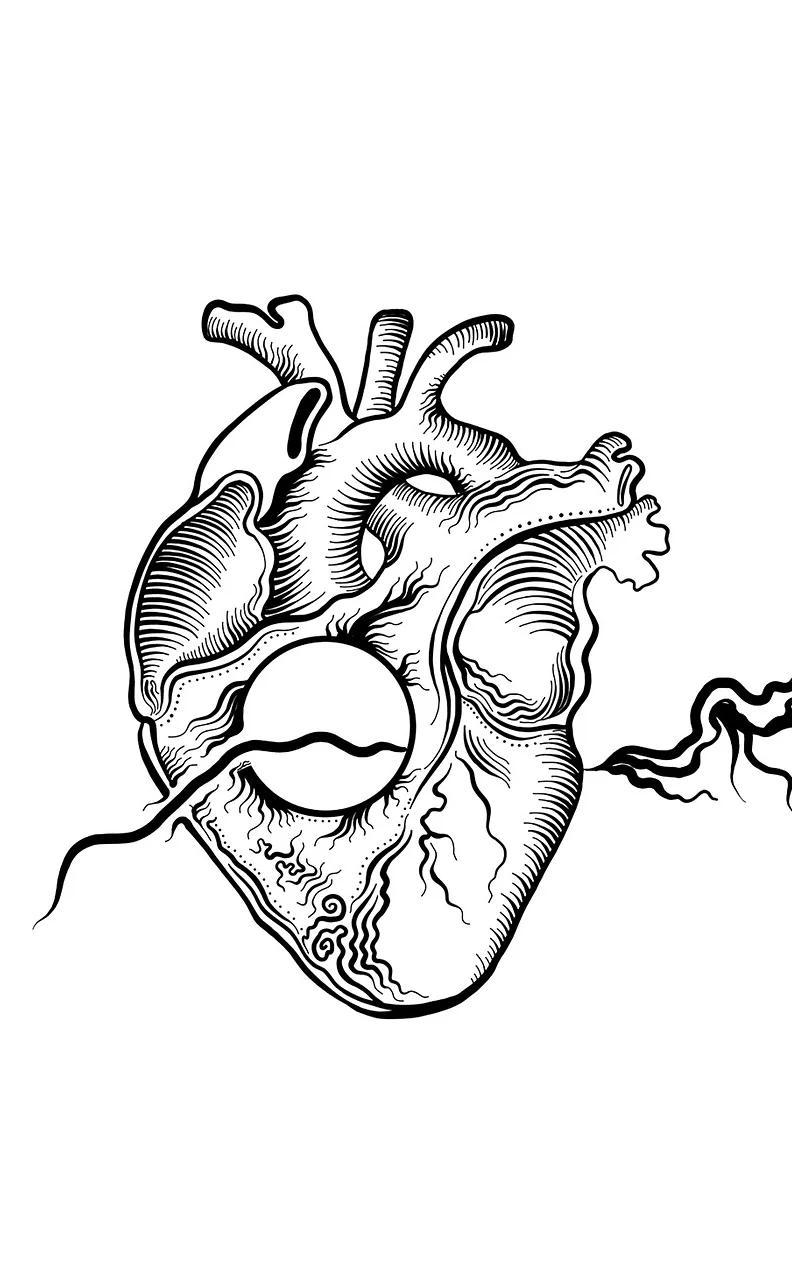
7 minute read
The Heartbeat of Medical Revolution: Contextualizing William Harvey’s Motu Cordis in the Tapestry of Early Modern Medicine
from PULSE Fall 2023
by Fareen Dhuka
By Alexander von Kumberg
Edited By Aman Majumdar
Advertisement
The renowned historian of medicine and professor of physiology, Kenneth J. Franklin, whose translation of Harvey’s essay is used in the following article, exclaimed: “Harvey’s Exercotatio Anatomica de Motu Cordis et Sanguinis in Animalibus (1682) is the most important work in the history of medicine.”
The truth of such a statement can hardly be questioned. Indeed, Harvey’s genius is unveiled in his Motu Cordis. This work formulated a modern model of cardiovascular anatomy and physiology. However, the piece does not solely display Harvey’s medical and scientific prowess; rather, its majestic simplicity and embodiment of the early scientific method truly earns it its laurels. In many ways, Motu Cordis perfectly reflects the intellectual zeitgeist of the early 17th century, namely the early scientific revolution and the embers of enlightenment. In order to fully appreciate Harvey and his Motu Cordis, one must comprehend the historical backdrop behind the man and the text.
William Harvey was born on April 1st, 1578, in Folkestone, England and died in 1657, an era of immense social and political upheaval in Britain and the European continent as a whole. By the mid-16th century, Europe began to depart from a culture of Renaissance Humanism and enter the tumultuous age of rival creeds, whether it be theological antitheses of Catholicism and Protestantism, or the rise of absolute monarchies and the birth of recognizable nation states. Indeed, this backdrop culminated in the Thirty Years War, which laid waste to central Europe and caused the deaths of more than 8 million people, 20% of Europe’s population. Harvey also lived through the English Civil War ending in 1651 and taking the lives of 7% of England’s population. With wars come political and social changes. Born early enough to see the defeat of the Spanish Armada in 1588 – in which his father, Thomas Harvey played a role as mayor of Folkstone – Harvey was born an Elizabethan. The conclusion of the Tudor dynasty, with the death of the Virgin Queen, Elizabeth I soon followed. Subsequently, Harvey witnessed the fanfare that defined James I’s Jacobean England and the early Stuarts before its polar opposite replaced it; that is, Oliver Cromwell’s Puritan theocracy. Yet, despite the brutal conflicts that orbited Harvey, new intellectual movements and ideas were simultaneously being formulated across the continent. From Galileo Galilei’s telescopes to Johannes Kepler’s laws of planetary motion, and from Antonie van Leeuwenhoek’s microscope to Francis Bacon’s scientific method, such behemoths were William Harvey’s contemporaries. Indeed, despite the plagues and conflicts that tormented Europe, Harvey lived an inquisitive life devoted to his patients and the medical sciences.
William Harvey was the eldest of nine children from Thomas Harvey’s second marriage to Joan Hawke. His mother – a devout Anglican – instilled a love for the faith and liturgy, which in turn lent Harvey his charity and virtue. His father was a dedicated and laborious worker. With such parents, there is no doubt that Harvey lived a life in tune with one of his most famed sayings: “Dii laboribus omnia vendunt” (the gods give all for effort). He was first educated in reading, writing, and Latin in Canterbury Grammar School as a fee-paying scholar. The sixteen-year-old Harvey was admitted to Gonville & Caius College, Cambridge in 1593. It was there that he began to study medicine. Following the manner of the classical sophists, Harvey devoted himself to travel as widely as possible in the hope of acquiring wisdom. Accordingly, in 1600, he began his studies at the University of Padua, which starkly contrasted with Cambridge in its focus on anatomy as well as the liberties granted to students. It was there, on the feast day of St. Luke (patron saint of doctors) that Harvey devoted himself to medicine and enrolled in the lectures of the famed professor of anatomy, Hieronymus Fabricius of Aquapendente. Alongside Aquapendente, Harvey studied the great Andreas Vesalius, with comparative anatomy and Aristotelian embryology. In April of 1602, Harvey graduated from Padua as a Doctor of Medicine and was reincorporated as an M.D. in Cambridge. He then entered the college of physicians and in 1604 began his career at St. Bartholomew’s Hospital with the recommendation of King James I. Yet, Harvey was not solely a physician, but an avid scientist, who having been influenced by
Aquapendente’s rediscovering of venous valves, began to develop a new model of the circulatory system. Subsequently, Harvey presented Lumleian Lectures thrice in 1616. By 1618, he was titled Physician Extraordinary and in 1628, Harvey published the culmination of his work, De Motu Cordis.

The European medical sphere, as it had been since the Middle Ages, was burdened by the near infallible words of the great Hellenic philosophers and physicians, in particular the dictator of philosophy, Aristotle and the untouchable Galen of Pergamon. Whose meticulous writings, paired with a medieval obsession and later Humanist passion for all things classical, burdened innovation in the medical sciences. Yet, these goliaths of old had begun to erode with the writings of proto-scientific minds like Vesalius in the mid-16th century, who single handedly proved the fallibility of Galen in his De Humani Corporis Fabrica Libri Septem. However, despite such erosion, an abundance of European physicians would rebuke any who dared oppose Galen, which Harvey certainly did in his Motu Cordis. Indeed, in his letter to fellow physicians Harvey states, “while swearing allegiance to Mistress Antiquity, do they [philosophers] openly abandon Friend Truth and desert her in sight of all.” Yet, Harvey evidently triumphed the great achievements of the past, and worked to improve upon the foundation of the giants of old, not merely rebuke them. Indeed, Motu Cordis is laced with a certain reverence for Galen, and those he contradicts with his novel experiments.
Harvey refers to Galen as “the Sire of Physicians.” Moreover, the final chapters of Motu Cordis are focused on confirming the novel assertions made by way of recalling philosophical principles. For example, Harvey recalls Aristotle’s principle that, “death is a corruption for lack of warmth and all living things are warm, dying ones cold, there must be a site and source of warmth.” Harvey, uses this Aristotelian principle to claim that “this site is the heart, and that the heart is the beginning of life.” Thus, rather than simply rebuking the ancient, Harvey laid his novel discoveries pulse 5 upon the columns of the great minds of old, legitimizing his discoveries. A glaring novelty in Motu Cordis is the emphasis on experimentation and self-inquiry. The most prolific investigation is Harvey’s use of ligatures, or threads tied around blood vessels. Harvey writes in a manner that invites the readers to partake in the experiments themselves: “Now make a test on a man’s arm by applying such a bandage [ligature] as they use in bloodletting… the test is better made in a lean subject with rather wide veins… In such a limb everything will be much more clearly seen.” Moreover, Harvey, in a somewhat Aquinian manner, imagines what objections could be made against his theories and how one would resolve them: “The objector may remain unconvinced and insist on adding that, although blood can escape with abnormal rapidity when an artery is cut open… so great an amount of blood cannot pass through them in so short a space of time that it must make the return journey to the heart. To this the answer should be that our previous reckoning shows, on balance, that the extra amount of blood contained in the full, dilated heart… is for all practical purposes the amount, which is emitted at each heartbeat, and so passes in such quantity into the arteries.” What follows from Harvey’s experimental layout, is a description of what occurs and how it proves his hypotheses on circulation. Indeed, after applying the tight ligature around the arm, which cuts off blood flow from arteries and veins, the arm below the ligature turned pale and felt cool. However, the upper arm turned red and warm. After the ligature was loosened slightly, blood from the arteries flowed into the lower arm. This is permissible as arteries are deeper in the body compared to veins. This in turn resulted in a swollen, red, and warm lower arm. Hence, Harvey concluded from this simple experiment that arterial blood travels to the extremities, while venal blood travels back to the heart, as arterial blood is sent to supply nutrients to the body before returning to the heart via the veins to be sent to the lungs via pulmonary arteries. By way of laying out his experiments Harvey formulated the modern understanding of the circulatory system in Motu Cordis. Indeed, he concludes as follows: “Since calculations and visual demonstrations have confirmed all my suppositions… I am obliged to conclude that in animals the blood is driven round a circuit with an unceasing, circular sort of movement, that this is an activity or function of the heart which it carries out by virtue of its pulsation.” Thus, by way of presupposing the thoughts of objectors, answering them in writing, and proving hypotheses by way of laying out detailed and replicable experiments, Harvey formulates and legitimizes his new circulatory model to his readers.
Thus, I have sought to give credence to Franklin’s exclamation that Motu Cordis is the most critical and insightful medical work ever composed. Indeed, it is undoubtedly the case that any and all budding physicians should read the essay. Its startling simplicity, eloquent tone, and masterful description of experimentation as well as anatomy and physiology truly instill a certain sense of awe and frisson in the reader. It is far too easy for modern students of medicine to refer to our discipline’s past with those despicable scientistic lenses in which all is considered an antediluvian vestige of a bygone age. Yet, Motu Cordis instills a contrary understanding. The respectful yet just manner in which Harvey confronts and reflects on his predecessors – both ancient and medieval – reflects his virtue and wisdom. In so doing, Harvey would manage to gain the renown he so dearly wished for. Indeed, the introduction of Motu Cordis concludes with a melancholic statement: “Finally, I have published so that, if something useful and serviceable should accrue to the republic of letters through my work in this field… others might see that I have not lived idly.” There is no doubt that Motu Cordis served this fear well, as it has been of the utmost use to students and physicians for centuries. Critically, Harvey asserts, “[I] may perchance prove… that others, given this lead, and relying on more productive talents, may find an opportunity to carry out the task more accurately and to investigate more skillfully.” And thus, the scientific endeavor has built upon Harvey in the same manner Galen built upon Hippocrates, and Ibn-al Nifis on Galen, and so on. The scientific edifice – perhaps most particularly in the field of medicine – requires a respect and knowledge of the great minds of old, to build the foundation for future generations of physicians. Such a statement is etched in the pages of Harvey’s Motu Cordis, and must necessarily be incorporated in the minds of all students of medicine.
References:
Harvey, William, & Franklin, Kenneth Kenneth (1977). The Circulation of the Blood and Other Writings, J. M. Dent & Sons.







